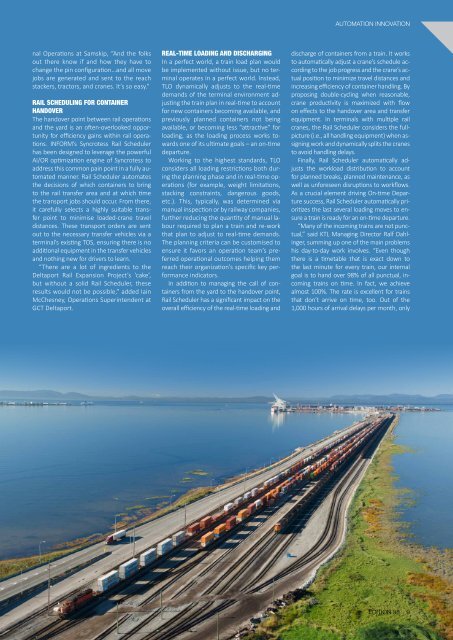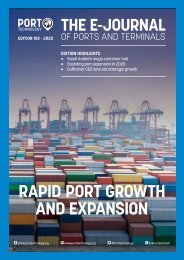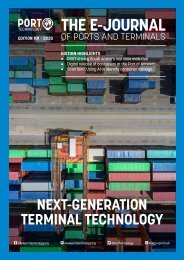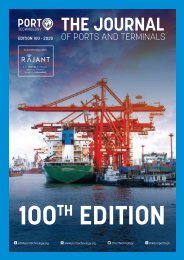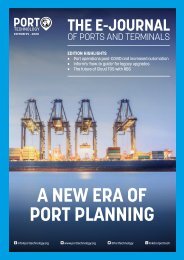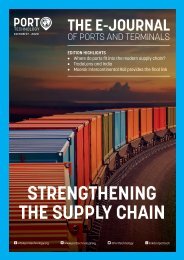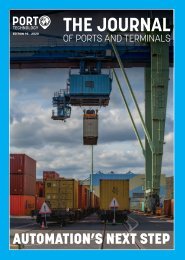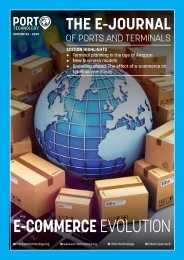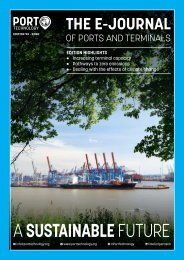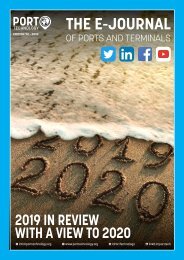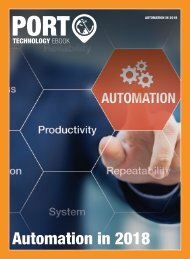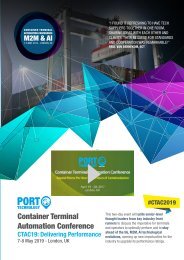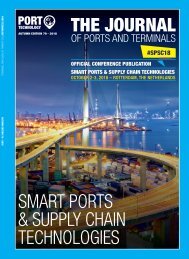Automation Innovations
As we enter the second half of 2020 the full effects of the COVID-19 pandemic are now being realised across the global economy and the port industry. For many, cargo throughput has been significantly decreasing compared with the same period for 2019. For example, the Port of Los Angeles handled 581,665 TEUs in May, a 29.8
As we enter the second half of 2020 the full effects of the COVID-19 pandemic are now being realised across the global economy and the port industry. For many, cargo throughput has been significantly decreasing compared with the same period for 2019.
For example, the Port of Los Angeles handled 581,665 TEUs in May, a 29.8
Create successful ePaper yourself
Turn your PDF publications into a flip-book with our unique Google optimized e-Paper software.
AUTOMATION INNOVATION<br />
nal Operations at Samskip, “And the folks<br />
out there know if and how they have to<br />
change the pin configuration…and all move<br />
jobs are generated and sent to the reach<br />
stackers, tractors, and cranes. It’s so easy.”<br />
RAIL SCHEDULING FOR CONTAINER<br />
HANDOVER<br />
The handover point between rail operations<br />
and the yard is an often-overlooked opportunity<br />
for efficiency gains within rail operations.<br />
INFORM’s Syncrotess Rail Scheduler<br />
has been designed to leverage the powerful<br />
AI/OR optimization engine of Syncrotess to<br />
address this common pain point in a fully automated<br />
manner. Rail Scheduler automates<br />
the decisions of which containers to bring<br />
to the rail transfer area and at which time<br />
the transport jobs should occur. From there,<br />
it carefully selects a highly suitable transfer<br />
point to minimise loaded-crane travel<br />
distances. These transport orders are sent<br />
out to the necessary transfer vehicles via a<br />
terminal’s existing TOS, ensuring there is no<br />
additional equipment in the transfer vehicles<br />
and nothing new for drivers to learn.<br />
“There are a lot of ingredients to the<br />
Deltaport Rail Expansion Project’s ‘cake’,<br />
but without a solid Rail Scheduler, these<br />
results would not be possible,” added Iain<br />
McChesney, Operations Superintendent at<br />
GCT Deltaport.<br />
REAL-TIME LOADING AND DISCHARGING<br />
In a perfect world, a train load plan would<br />
be implemented without issue, but no terminal<br />
operates in a perfect world. Instead,<br />
TLO dynamically adjusts to the real-time<br />
demands of the terminal environment adjusting<br />
the train plan in real-time to account<br />
for new containers becoming available, and<br />
previously planned containers not being<br />
available, or becoming less “attractive” for<br />
loading, as the loading process works towards<br />
one of its ultimate goals – an on-time<br />
departure.<br />
Working to the highest standards, TLO<br />
considers all loading restrictions both during<br />
the planning phase and in real-time operations<br />
(for example, weight limitations,<br />
stacking constraints, dangerous goods,<br />
etc.). This, typically, was determined via<br />
manual inspection or by railway companies,<br />
further reducing the quantity of manual labour<br />
required to plan a train and re-work<br />
that plan to adjust to real-time demands.<br />
The planning criteria can be customised to<br />
ensure it favors an operation team’s preferred<br />
operational outcomes helping them<br />
reach their organization’s specific key performance<br />
indicators.<br />
In addition to managing the call of containers<br />
from the yard to the handover point,<br />
Rail Scheduler has a significant impact on the<br />
overall efficiency of the real-time loading and<br />
discharge of containers from a train. It works<br />
to automatically adjust a crane’s schedule according<br />
to the job progress and the crane’s actual<br />
position to minimize travel distances and<br />
increasing efficiency of container handling. By<br />
proposing double-cycling when reasonable,<br />
crane productivity is maximized with flow<br />
on effects to the handover area and transfer<br />
equipment. In terminals with multiple rail<br />
cranes, the Rail Scheduler considers the fullpicture<br />
(i.e., all handling equipment) when assigning<br />
work and dynamically splits the cranes<br />
to avoid handling delays.<br />
Finally, Rail Scheduler automatically adjusts<br />
the workload distribution to account<br />
for planned breaks, planned maintenance, as<br />
well as unforeseen disruptions to workflows.<br />
As a crucial element driving On-time Departure<br />
success, Rail Scheduler automatically prioritizes<br />
the last several loading moves to ensure<br />
a train is ready for an on-time departure.<br />
“Many of the incoming trains are not punctual,”<br />
said KTL Managing Director Ralf Dahlinger,<br />
summing up one of the main problems<br />
his day-to-day work involves. “Even though<br />
there is a timetable that is exact down to<br />
the last minute for every train, our internal<br />
goal is to hand over 98% of all punctual, incoming<br />
trains on time. In fact, we achieve<br />
almost 100%. The rate is excellent for trains<br />
that don’t arrive on time, too. Out of the<br />
1,000 hours of arrival delays per month, only<br />
EDITION 98 9


